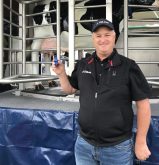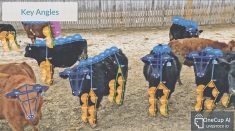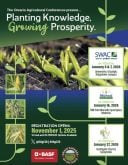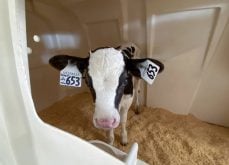The third annual World Dairy Expo Tech Spotlight showcased tools to improve on-farm efficiencies, traceability and monitoring.
“We know the pivotal role (tech) has played to get us where we are today and there’s no denying it’s going to play an impactful role and part in where we go in profitability, animal health and sustainability,” said Laura Herschleb, general manager of the expo.
Hosted by AgriTech Capital, the online sneak peek featured offerings from Labby, Milc Group, smaXtec, Cattle Eye, Milk Moovement, Nedap, EIO diagnostics, Ever Ag and Dalex, plus an industry expert panel discussion.
Read Also

Agritechnica 2025: Day 3
Zoomlion’s diesel-electric hybrid combine drives draws interest, data standards look to keep up to technology change and tractors of the year are named at German farm show Agritechnica 2025.
Why it matters: Precision ag in dairy continues to streamline animal health, feed, traceability, labour management and data use but faces adoption challenges.
[RELATED] VIDEO: Youth takes home honours at World Dairy Expo
There are two stumbling blocks to the adoption of dairy production technology, said Jeffery Bewley, AgriTech Capital president and DTS panellist.
The first is tech teams’ limited dairy barn experience to guide development and understand producer needs so they can improve the product.
The second is creating user-friendly technology that converts data into manageable and useful information.
“There’s a technology graveyard out there of technologies we talked about five years ago, 15 years ago. It’s critical to the success of that technology,” said Bewley. “I see many technologies who’ve done a wonderful job of [making technology seamless] … and were very successful because they listened to their producers.”
DTS panelist Julio GiordanaIt agreed that developers must ensure technology fits a farm’s management style, just as developers must create adaptable and scalable products for various farm production systems.
“Technology should be seen as a way to address issues on the farm, rather than just adopting technology and then find the issues,” said Giordanalt. “Be open-minded, a little bit skeptical and find the areas of the dairy that can be improved through, and by, technology.”
Data into action
Nedap’s Cow Control has user-friendly tags that track a cow’s heat cycling, inactivity, rumination and location, and can integrate that information into most dairy management systems.
It also boasts minimal tag loss, an eight-year or better lifespan and a failure rate below one per cent.
“Analyzing group trends can be a slick way to see how the cows are responding to environmental factors,” said Tera Baker of Nedap. “We created an augmented reality so a herd manager or veterinarian can walk through the pens and see each cow’s information. They can enter data points such as breeding, treatment and more without needing any hand-held devices.”
[RELATED] Dairy start-ups target individual producer problems
Tracking cows allows producers to manage by exception instead of disrupting the whole herd. They can address emerging issues days before clinical signs appear and design preventive care protocols.
“Getting cows pregnant in an ethical and humane way that is easy to explain to consumers is one of the first reasons a lot of farms look at this system,” Baker said.
“We also think about how we can make an environment that will be more attractive to your labour force.”
She said enticing new and younger talent to the agriculture industry is easier when smart devices play a role in overall animal health and welfare.
Ever.Ag’s artificial intelligence program ‘Cainthus’ and Milc Group’s ‘Animal’ aggregate data to improve milk production, animal welfare and profitability through labour efficiency.
“Farmers are constantly told to make data-driven decisions, but all that data creation comes at a cost, mentally and physically,” said Ryne Braun, segment leader at Ever.Ag.
“Our mission … is to make the journey from creating data to utilizing those data as easy as possible.”
On-farm cameras for pen monitoring and passive data collection allow Cainthus to track feed bunk management, cow behaviour and employee protocols through the ALUS Nutrition and ALUS Behaviour systems.
ALUS Nutrition provides real-time alerts and tracking of low feed issues, such as missed push-ups, late deliveries or sub-optimal deliveries when cows leave for the parlour. ALUS Behaviour follows the cow’s “free time” and consolidates it with chores to optimize feed deliveries and maximize rest time.
Cainthus ties outputs, such as feed and milk shipped, with operational and supply chain metrics to increase profitability.
Milc Group’s Animal falls under the One business management software suite, including animal and feed management, online employee training, farming and waste management, facility, financial and risk management.
Animal is secure, cloud-based herd management software with data accessible from any device. It allows producers to set parameters for animal care alerts. Additionally, Animal can send individual work assignments to employees and log completion.
Bewley anticipates that dairy farms of all sizes will one day have a chief information officer, with dairy management and data statistics experience, who will monitor and interpret farm data.
“There can be such large benefits, economically, to adopting these technologies and using the data well,” he said. “If you’re not doing it, you may lose a significant competitive advantage to those who are.”
Bewley said advances in wearable technology and use of the milking parlour as a lab for milk analysis are exciting highlights.
Mastitis causes an estimated $32 billion annual global loss to the industry, so it’s no surprise technology is making strides in early detection and treatment.
Labby’s Optical Milk Analyser provides on-farm milk testing within 10 seconds, including butterfat, milk protein and somatic cell count results. It has an integrated data portal for herd milk management.
[RELATED] Modifying MUN testing in dairy cow milk
Canadian-founded company EIO Diagnostics’ thermal sensor detects mastits, is used at the beginning of a rotary parlour, captures infrared udder images and attaches them to RFID tags to create a rolling five-day image bank.
“Our whole focus is creating a tool that is simple to use, easy to install and maintain and integrates seamlessly into the workflow of the barn,” said EIO Diagnostics CEO Tamara Leigh. “We understand that labour comes at a premium. This is a skilled task … and you need that consistency to manage well for milk quality and productivity down the road. Even if you’re not treating (mastitis), you have to manage it.”
SmaXtec’s TruRumi bolus-based measurement tool tracks inner body temperature, activity and rumination, shifting cow management from a reactive to a proactive model.
“We want to stay ahead of the curve,” said smaXtec’s Dr. Stefan Scherer. “If you want to have true health management, you need to be able to predict the state of the cow and the potential disease coming.”
He said TruRumi detects common diseases like mastitis, milk fever and ketosis four days before clinical signs appear.
“(A producer) sees a return on investment through less medication, more milk, less labour and more efficient work time.”
Milk Moovement, founded in Newfoundland and based in Nova Scotia, is pushing data traceability and milk forecasting to the foreground by connecting stakeholders in real-time.
“Without data and real-time information about your supply chain, you just can’t run a dynamic supply chain,” said Robert Forsythe, Milk Moovement CEO and co-founder. “We believe that data is the key to everything.”
Milk Moovement is a fluid milk supply chain tracker, from farm to processor. It can calculate regional on-farm milk supply, allowing users to more quickly respond to changing demand.
It manages more than 30 billion pounds of milk yearly through 2,500 farms. Forsyth said it eliminates data silos that have developed through old software, outdated platforms, manual processes and human error.
“We like to say we’re doing the impossible by getting dairy truck drivers on an app,” Forsyth said. “So, it must be easy to use. It must be enjoyable to use and simple. That’s what we strive to do.”
Dalex’s cloud-based data-sharing software is designed to address the greatest feed industry challenge: the constant shifting of availability, quality and price of ingredients along with changing consumer and client needs, to result in optimal animal health, performance and affordability.
“We don’t just want a calculator. We want something that will take the biology into account and the economics of it,” said business development vice-president Dallas Shaw. He said the program is available in English, Spanish and Chinese.
Dalex combines biological models and peer-reviewed research to provide animal health management for producers, consultants, nutritionists or large feed companies, which saves time and limits errors.
“It’s very customizable; the architecture is designed that way,” Shaw said. “The benefits of a cloud-based technology are you have real-time data, and you can collaborate with colleagues out in the field and share information without errors.”
Up-and-coming tech
CattleEye is a hardware-independent livestock monitoring platform that provides locomotion monitoring and scoring for individual cows’ hoof health.
The autonomous system uses a standard security camera mounted over a milking parlour’s exit. It uses video footage and artificial intelligence algorithms to analyze individual cow movement.
Research on CattleEye shows a 10 per cent decrease in lameness, equating to approximately $120 per cow in annual savings.
The system integrates with several herd management systems, and data is exportable via a CSV file for analysis and trim list creation.
Installed on 38 farms, the United Kingdom-based software oversees 47,566 cows.
– With files from Jennifer Glenney, Farmtario contributor















